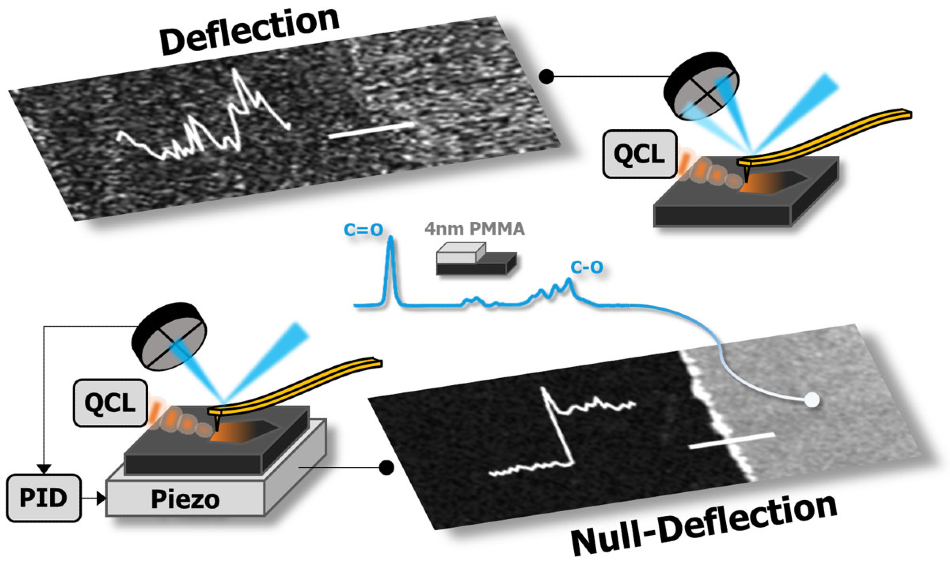Jun 29 2020
At the Beckman Institute for Advanced Science and Technology, scientists have designed the latest technique to enhance the detection ability of nanoscale chemical imaging by making use of atomic force microscopy.
 Chemical signal produced by a 4 nm thick polymer film collected using previous deflection AFM-IR detection, top, compared to the new null-deflection approach. Image Credit: Beckman Institute for Advanced Science and Technology.
Chemical signal produced by a 4 nm thick polymer film collected using previous deflection AFM-IR detection, top, compared to the new null-deflection approach. Image Credit: Beckman Institute for Advanced Science and Technology.
Such enhancements decrease microscope noise, enhancing the accuracy and variety of samples that can be examined.
The research titled “Closed-Loop Atomic Force Microscopy-Infrared Spectroscopic Imaging for Nanoscale Molecular Characterization” was recently published in the Nature Communications journal.
Atomic force microscopy is employed to scan materials’ surfaces to produce an image of their height. However, the method cannot easily find the molecular composition. Earlier, scientists designed a combination of infrared and AFM spectroscopy known as AFM-IR.
In an AFM-IR microscope, a cantilever—a beam linked to a support at one end and a sharp tip at the other—is used to quantify subtle movements of a sample by irradiating with an IR laser. When the sample absorbs light, it expands and deflects the cantilever, thereby producing an IR signal.
Although the technique is widely used, there is a limit to its performance. The problem is that there were unknown sources of noise that limited the quality of the data.
Rohit Bhargava, Founder Professor of Engineering and Director of the Cancer Center, University of Illinois at Urbana-Champaign
The team designed a theoretical model to gain insights into how the instrument functions and thus recognize the sources of noise. Also, they developed a new method to detect the IR signal with enhanced accuracy.
The cantilever deflection is susceptible to noise which becomes worse as the deflection increases. Instead of detecting cantilever deflection, we used a piezo component as a stage to maintain zero deflection.
Seth Kenkel, Graduate Student, Chemical Imaging and Structures Laboratory, University of Illinois at Urbana-Champaign
Kenkel continued, “By applying a voltage to the piezo material, we can maintain small deflection with low noise while recording the same chemical information which is now encoded in the piezo voltage.”
The Chemical Imaging and Structures Laboratory is headed by Bhargava.
Rather than shifting the cantilever, the team utilized the movement of the piezo-crystal to record the IR signal. “This is the first time anyone has controlled a piezo actuator to detect the signal. Other researchers work around challenges such as noise by using more complex detection systems that don’t address the underlying problems associated with AFM-IR,” stated Kenkel.
According to Bhargava, “People have only been able to use this technique to measure samples that have a strong signal because of the noise problem. With the improved sensitivity, we can image a much smaller volume of samples, like cell membranes.”
Besides quantifying a wider range of samples, the team believes this method can be used to measure smaller volumes of samples. “We could use this technique to look at complex mixtures that are present in small volumes, like a single lipid bilayer,” added Bhargava.
The new technique developed by the Bhargava lab is exciting. Our group is interested in using this technique immediately to learn about protein deformation on complex surfaces.
Catherine Murphy, Head, Department of Chemistry, Beckman Institute for Advanced Science and Technology
Murphy is also the Larry Faulkner Endowed Chair in Chemistry.
The study was financially supported in part by the National Science Foundation via the U of I Materials Research Science and Engineering Center DMR-1720633 and the National Institute of Biomedical Imaging and Bioengineering of the National Institutes of Health under Award Number T32EB019944.
Journal Reference:
Kenkel, S., et al. (2020) Closed-loop atomic force microscopy-infrared spectroscopic imaging for nanoscale molecular characterization. Nature Communications. doi.org/10.1038/s41467-020-17043-5.
Source: https://beckman.illinois.edu/